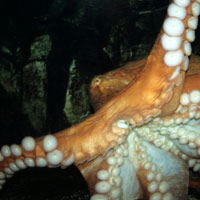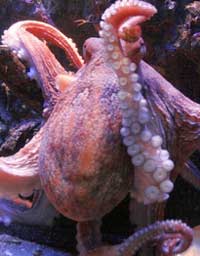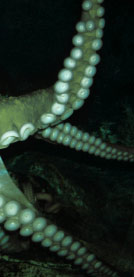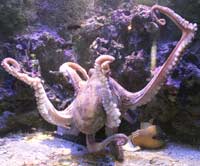|

Octopuses are characterized by their eight arms (not tentacles),
usually bearing suction cups. These arms are a type of muscular
hydrostat. Unlike most other cephalopods, the majority of octopuses
have almost entirely soft bodies with no internal skeleton. They
have neither a protective outer shell like the nautilus, nor any
vestige of an internal shell or bones, like cuttlefish or squid.
A beak, similar in shape to a parrot's beak, is their only hard
part. This enables them to squeeze through very narrow slits between
underwater rocks, which is very helpful when they are fleeing from
morays or other predatory fish.

 Long arms, short lives: Octopuses have a relatively short life span, and some species live
for as little as six months. Larger species, such as the North Pacific
Giant Octopus, may live for up to five years under suitable circumstances.
However, reproduction is a cause of death: males can only live for
a few months after mating, and females die shortly after their eggs
hatch, for they neglect to eat during the (roughly) one month period
spent taking care of their unhatched eggs. Long arms, short lives: Octopuses have a relatively short life span, and some species live
for as little as six months. Larger species, such as the North Pacific
Giant Octopus, may live for up to five years under suitable circumstances.
However, reproduction is a cause of death: males can only live for
a few months after mating, and females die shortly after their eggs
hatch, for they neglect to eat during the (roughly) one month period
spent taking care of their unhatched eggs.
Three hearts! Octopuses have three hearts. Two pump blood through each of the
two gills, while the third pumps blood through the body. Octopus
blood contains the copper-rich protein hemocyanin for transporting
oxygen. Less efficient than the iron-rich hemoglobin of vertebrates,
the hemocyanin is dissolved in the plasma instead of being bound
in red blood cells and gives the blood a blue color. Octopuses draw
water into their mantle cavity where it passes through its gills.
As a mollusc, octopus gills are finely divided and vascularilzed
outgrowths of either the outer or the inner body surface.
 Three defense strategy: Three defensive mechanisms are typical of octopuses: ink sacs,
camouflage, and autotomising limbs. Most octopuses can eject a thick
blackish ink in a large cloud to aid in escaping from predators.
They also have specialized skin cells both for color changing and
light reflection and refraction. They use this ability to blend
into the environment to hide, communicate with other octopuses,
or warn. The very poisonous Blue-ringed Octopus becomes bright yellow
with blue rings when it is provoked. When under attack, some octopuses
can autotomise their limbs, in a similar manner to skinks and other
lizards. The crawling arm serves as a distraction to would-be predators;
this ability is also used in mating. A few species, such as the
Mimic Octopus have a fourth defense mechanism. They can combine
their highly flexible bodies with their color changing ability to
accurately mimic other, more dangerous animals such as lionfish
and eels. Three defense strategy: Three defensive mechanisms are typical of octopuses: ink sacs,
camouflage, and autotomising limbs. Most octopuses can eject a thick
blackish ink in a large cloud to aid in escaping from predators.
They also have specialized skin cells both for color changing and
light reflection and refraction. They use this ability to blend
into the environment to hide, communicate with other octopuses,
or warn. The very poisonous Blue-ringed Octopus becomes bright yellow
with blue rings when it is provoked. When under attack, some octopuses
can autotomise their limbs, in a similar manner to skinks and other
lizards. The crawling arm serves as a distraction to would-be predators;
this ability is also used in mating. A few species, such as the
Mimic Octopus have a fourth defense mechanism. They can combine
their highly flexible bodies with their color changing ability to
accurately mimic other, more dangerous animals such as lionfish
and eels.
As smart as a cat: Octopuses are highly intelligent, probably the most intelligent
of any of the invertebrates, with their intelligence supposedly
comparable to that of the average housecat. Maze and problem-solving
experiments show that they have both short- and long-term memory,
although their short lifespans limit the amount they can ultimately
learn.
 Arm nerves: An octopus has a highly complex nervous system, only part of which
is localized in its brain. Two-thirds of an octopus's neurons are
found in the nerve cords of its arms, which have a remarkable amount
of autonomy. Octopus arms show a wide variety of complex reflex
actions arising on at least three different levels of the nervous
system. Some octopuses, such as the mimic octopus, will move their
arms in ways that emulate the movements of other sea creatures. Arm nerves: An octopus has a highly complex nervous system, only part of which
is localized in its brain. Two-thirds of an octopus's neurons are
found in the nerve cords of its arms, which have a remarkable amount
of autonomy. Octopus arms show a wide variety of complex reflex
actions arising on at least three different levels of the nervous
system. Some octopuses, such as the mimic octopus, will move their
arms in ways that emulate the movements of other sea creatures.
Slow travel - crawl, Fast travel - Swim: Octopuses move about by crawling or swimming. Their main means
of slow travel is crawling, with some swimming. Their only means
of fast travel is swimming. Their fastest movements can be up to
eighty five miles per hour. They can go extremely fast due to the
fact that their three hearts have to pump through each vascular
pump at a paralell sequence. They go this fast if hungry or if in
danger.
Pretend to be a coconut: They crawl by walking on their arms, usually on many at once, on
solid surfaces, while supported in water. In 2005 it was reported
that some octopuses can walk on two arms on a solid surface, while
at the same time imitating a coconut or a clump of seaweed.
They swim by expelling a jet of water from a contractile mantle,
and aiming it via a muscular siphon.

 When octopuses reproduce, males use a specialized arm called a hectocotylus
to insert spermatophores (packets of sperm) into the female's mantle
cavity. The hectocotylus is usually the third right arm. In some
species, the female octopus can keep the sperm alive inside her
for weeks until her eggs are mature. After they have been fertilized,
the female lays roughly 200,000 eggs (this figure dramatically varies
between families, genera, species and also individuals). When octopuses reproduce, males use a specialized arm called a hectocotylus
to insert spermatophores (packets of sperm) into the female's mantle
cavity. The hectocotylus is usually the third right arm. In some
species, the female octopus can keep the sperm alive inside her
for weeks until her eggs are mature. After they have been fertilized,
the female lays roughly 200,000 eggs (this figure dramatically varies
between families, genera, species and also individuals).
The female hangs these eggs in strings from the ceiling of her
lair, or individually attatched to the substratum depending on the
species. After the eggs hatch, the young larval octopuses must spend
a period of time drifting in clouds of plankton, where they feed
on copepods, larval crabs and larval seastars until they are ready
to sink down to the bottom of the ocean, where the cycle repeats
itself. In some deeper dwelling species, the young do not go through
this period. This is a dangerous time for the larval octopuses;
as they become part of the plankton cloud they are vulnerable to
many plankton eaters
All text is available under the terms
of the GNU Free Documentation License
|